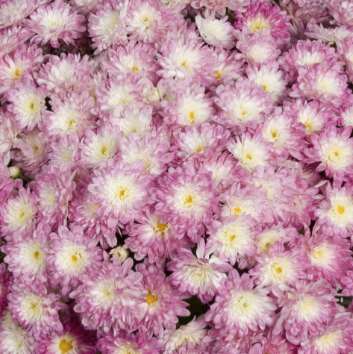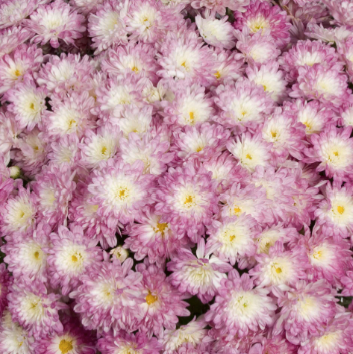
Crop Culture Report: Mystic Mums Series
Garden mums are a strong part of our culture during the fall season. For generations across North America people have been using garden mums to beautify their homes and businesses. Fides began as a chrysanthemum breeding company more than 45 years ago and with the recent breeding leading to the new Mystic Mums*, Fides and Fides Oro are building and improving on that strong North American tradition.
Mystic mums are very versatile as they can be grown and marketed in any container size either as part of shaded programs or under natural season photoperiods. Selected by American growers for American growers, Mystic mums are bred for large decorative flowers, a flexible and mounding habit, and exciting and unique colors with great color retention and long shelf life. The variety names were selected to make variety selection easy for the right season and program.
There are 35 Mystic mum varieties that have an amazing combination of colors and performance. The earliest flowering cultivars are those that start with the Daybreak selection name and naturally flower at the end of August. The Sunbeam selections naturally flower in early September. These varieties are then followed by the Meridian selections that flower in mid September, the Eventide selections for late September and finally, the Afterglow selections that extend the season well into October. In addition to excellent natural day flowering, 17 of the Mystic mum varieties are rated for fast and easy shade or short-day production.
Since the beginning, the Mystic mums trialing process has included selecting varieties with a higher tolerance to diseases including Bacterial Leaf Spot and Chrysanthemum White Rust.
Crop Culture
Garden mums are easy to grow when basic guidelines are followed. Stick unrooted cuttings as soon as they arrive into a moist media. Maintain a media temperature of 73 to 75° F after sticking and provide long days using a four-hour night interruption from 10 p.m. to 2 a.m. at a minimum of 10 foot-candles during rooting to prevent premature budding. This helps prevent premature bud set for any grower before June 1 and southern growers (who have naturally shorter days all season due to latitude) and any time there are cool temperatures. Cuttings stuck after July 21 should always be lighted as the days shorten.
Mist as needed to keep the cutting turgid and reduce mist frequency as roots form. From day one, add 50-ppm nitrogen from 17-5-17 or a similar fertilizer to the mist solution. If night temperatures drop below 68° F apply Florel at a rate of 500 ppm once the cutting starts rooting, typically about 10 days after sticking, to prevent premature bud set and repeat in two weeks. Many growers apply Florel to all cuttings about 10 to 12 days after sticking as an insurance policy against early flower-bud set. After roots start to develop increase nitrogen to 200 ppm 17-5-17 twice a week. Allow 14 to 21 days for rooting depending on the cell size. Liners should be transplanted 18 to 21 days after sticking. Later transplanting can result in stunting of plants and slower take off after transplant. In addition, lateral branching can be adversely affected by delayed transplanting.
Plant rooted cuttings upon receipt in a loose, well-drained media and water in fully. We generally suggest watering in cuttings with 200-ppm nitrogen from 17-5-17 or 20-10-20. Mystic garden mums do not require pinching for natural day production but plants finishing in black out should be pinched in 14 to 18 days after sticking, especially for smaller container sizes. Plants finishing under normal days usually do not need pinching although there is no down side to pinching.
The pH for a soilless media should ideally be 5.8 to 6.2 although plants generally grow without problems from 5.3 to 6.6.
Fertilize plants with a complete N-P-K fertilizer solution at a rate of 100 to 125 ppm; this should be applied at every irrigation, even after a rain. Many growers have found that higher “recharge” fertilizer rates are not necessary after a heavy rain if they irrigate immediately following the rain with their normal fertilizer solution. As the saying goes, wet is wet so irrigation to a wet pot does not make it any wetter, it just adds nutrients back to the media.
Media containing bark likely will require a higher fertilizer rate such as 175 to 200 ppm, depending on the amount and bark composition. When fertilizing at lower nitrogen rates of 100 to 125 ppm, commercial fertilizer minor nutrients may not be adequate if not supplemented. Additional minor nutrients from a balanced blend should be added to the fertilizer solution so the nutrient solution delivers about 1-ppm iron, 0.5-ppm manganese, 0.5-ppm zinc, 0.25-ppm copper, 0.25-ppm boron and 0.1-ppm molybdenum.
It is thought by many that stress causes early flower-bud set, but the only factors that promote early flower-bud set in mums are night temperatures below 68° F and short photoperiods. High fertilizer rates do not reverse premature buds. High temperatures, long days and Florel individually or preferably in combination will reverse premature flower bud set.
For many growers, garden mums are produced over a very long time duration starting in May and ending in October with multiple sticking and finishing dates. During this time, different crops are exposed to large differences in temperature and photoperiods. It is likely that at least one or more of these crops will be exposed to conditions that will result in premature flower-bud set resulting in small plants. This most often occurs for early crops and then again for late-season crops finishing in September and October. While not essential for all crops, premature flower-bud formation can be greatly prevented by application of Florel at 500 ppm to all crops every two weeks from time of sticking or time of transplant. The last application should be the before black out on short-day crops and eight weeks before scheduled shipment on normal-day crops.
Growth regulators such as daminozide (B-Nine and Dazide) and paclobutrazol (Bonzi and Piccolo) can be use for height control as needed. Daminozide should not be used when buds are pea-sized or larger to prevent flower delay. For late season height control, paclobutrazol drenches are best used to reduce flower delay. Follow label instructions for all chemicals.
Insects can be a problem on garden mums which include aphids, mites, various caterpillars, leafminer and thrips. Insects are not usually a significant problem with proper scouting to identify insects that are more prevalent and with early control.
Common diseases on garden mums are caused by Pythium, Fusarium and Rhizoctonia, bacterial leaf spot and leaf spots caused by Alternaria, Botrytis and Septoria. For disease prevention start with clean cuttings, media, equipment and exercise good cultural practices.
This new line of garden mums is winning over growers and turning heads at retail.



 Video Library
Video Library 




















